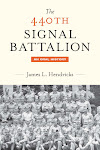Months before the actual formation of the 440th Signal Battalion, a small number of men, who were already serving in the US Army, were to become the first members of the yet-to-be battalion. Many of these men became the cadre, who's job it would be to train the new incoming men of the young unit. They were stationed throughout the lower forty-eight States: New Jersey, Georgia and Texas as well as several other locations.
Within days following Pearl Harbor, these men were sent to Camp Bowie, Texas. On December 10th 1941, they were placed on 'War-Time Duty' and moved to points along and near the US/Mexican border, including Comstock and Del Rio. The first job at hand was guard duty at rail and other bridges over the normally sleepy Rio Grand river. Some of the men from this time period have said that they were issued arms but not ammunition! At the same time, these early Signal Corpsmen were providing communications between the bridges and command posts by utilizing existing Western Union telephone/telegraph poles for their wires. At some point a few weeks after being sent to the border area for guard duty, the men were relieved by a unit of the 1st Cavalry.
Among one of the first contingents to arrive in Texas, were a dozen members of the 51st Signal Battalion from New Jersey. Most of these men - Regular Army NCO's - would form a growing number of cadre for the training of hundreds of enlistees and draftees who would soon be meeting them in Spokane, Washington.
Orders were issued that would soon include these 'Early Birds' on what would become the longest truck convoy in US Army history. Vehicles, equipment and personnel were being assembled on a crash basis. Their equipment and supplies were, in many cases, years old and consisted of trucks dating back to the late 1920's and early 1930's. Copper wire, C-rations and light arms were loaded into the aging trucks. Some of trucks had received a hasty coat of fresh paint, which did little to hide their antiquity.
The long trek to the Spokane, Washington, area began in the second half of January 1942. Their destination would be Geiger Field near Spokane. The mile-long convoy of trucks was lucky to cover 200 miles per day. They traveled the shortest, most direct route from Texas to Southern California then north to Spokane. Along the route, the men would make evening 'camp' on school athletic fields, public parks or other pre-arranged private land. Ocasionally they were able to use a school gymnasium as a sleeping area. Two 1 1/2 ton trucks were set up as kitchens and the midday meal normally consisted of little more than sandwiches and coffee.
Several of these Early Birds have made similar comments and told the same story about this journey of so many years ago. To a man, they remember the kindness and generousity of the people they met along the way. Local Boy Scouts and other organizations would greet them when they arrived at their designated camp site ad offer them food and encouragement. These meetings of Soldier and Civilian would live on in the memories of the young men.
Tuesday, December 25, 2007
Subscribe to:
Comments (Atom)



